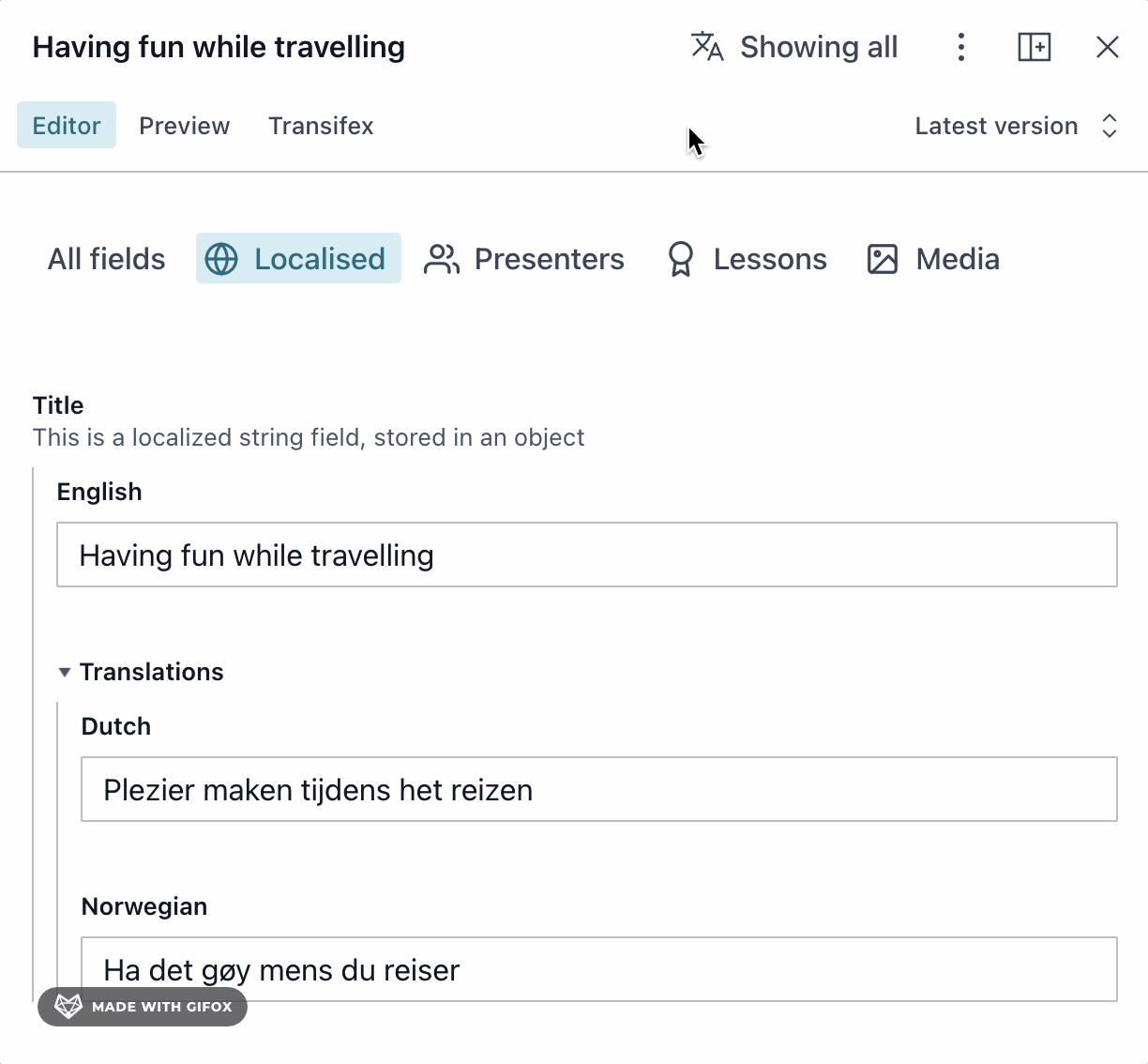@sanity/language-filter
This is a Sanity Studio v3 plugin.
For the v2 version, please refer to the v2 version.
Field-level translation filter Plugin for Sanity.io
A Sanity plugin that supports filtering localized fields by language

What this plugin solves
There are two popular methods of internationalization in Sanity Studio:
- Field-level translation
- A single document with many languages of content
- Achieved by mapping over languages on each field, to create an object
- Best for documents that have a mix of language-specific and common fields
- Not recommended for Portable Text
- Document-level translation
- A unique document version for every language
- Joined together by references and/or a predictable
_id - Best for documents that have unique, language-specific fields and no common content across languages
- Best for translating content using Portable Text
This plugin adds features to the Studio to improve handling field-level translations.
- A "Filter Languages" button to show/hide fields in an object of language-specific fields
- Configuration to set "default" languages which are always visible
For document-level translations you should use the @sanity/document-internationalization plugin.
Installation
npm install --save @sanity/language-filter
or
yarn add @sanity/language-filter
Usage
Add it as a plugin in sanity.config.ts (or .js), and configure it:
import {defineConfig} from 'sanity'
import {languageFilter} from '@sanity/language-filter'
export const defineConfig({
plugins: [
languageFilter({
supportedLanguages: [
{id: 'nb', title: 'Norwegian (Bokmål)'},
{id: 'nn', title: 'Norwegian (Nynorsk)'},
{id: 'en', title: 'English'},
{id: 'es', title: 'Spanish'},
{id: 'arb', title: 'Arabic'},
{id: 'pt', title: 'Portuguese'},
],
defaultLanguages: ['nb'],
documentTypes: ['page'],
filterField: (enclosingType, member, selectedLanguageIds) =>
!enclosingType.name.startsWith('locale') || selectedLanguageIds.includes(member.name),
})
]
})
Config properties:
supportedLanguages can be either:
-- An static array of language objects with id and title. If your localized fields are defined using our recommended way described here (https://www.sanity.io/docs/localization), you probably want to share this list of supported languages between this config and your schema.
-- A function that returns a promise resolving to an array of language objects with id and title. This is useful if you want to fetch the list of supported languages from an external source. See Loading languages for more details.defaultLanguages (optional) is an array of strings where each entry must match an id from the supportedLanguages array. These languages will be listed by default and will not be possible to unselect. If no defaultLanguages is configured, all localized fields will be selected by default.documentTypes (optional) is an array of strings where each entry must match a name from your document schemas. If defined, this property will be used to conditionally show the language filter on specific document schema types. If undefined, the language filter will show on all document schema types.filterField (optional) is a function that must return true if the field should be displayed. It is passed the enclosing type (e.g the object type containing the localized fields, the field, and an array of the currently selected language ids.
This function is called for all fields and in objects for documents that have language filter enabled.
Default: !enclosingType.name.startsWith('locale') || selectedLanguageIds.includes(field.name)apiVersion (optional) used for the Sanity Client when asynchronously loading languages.
Loading languages
Languages must be an array of objects with an id and title.
languages: [
{id: 'en', title: 'English'},
{id: 'fr', title: 'French'}
],
Or an asynchronous function that returns an array of objects with an id and title.
languages: async () => {
const response = await fetch('https://example.com/languages')
return response.json()
}
The async function contains a configured Sanity Client in the first parameter, allowing you to store Language options as documents. Your query should return an array of objects with an id and title.
languages: async (client) => {
const response = await client.fetch(`*[_type == "language"]{ id, title }`)
return response
},
@sanity/language-filter's asynchronous language loading does not currently support modifying the query based on a value in the current document.
Changes in V3
documentTypes
Language filter can now be enabled/disabled directly from a schema, using options.languageFilter: boolean.
When documentTypes is omitted from plugin config, use options.languageFilter: false in a document-definition to hide the filter button.
When documentTypes is provided in plugin config, use options.languageFilter: true in a document-definition to show the filter button.
Example:
export const myDocumentSchema = {
type: 'document',
name: 'my-enabled-language-filter-document',
options: {
languageFilter: true,
},
}
License
MIT-licensed. See LICENSE.
Develop & test
This plugin uses @sanity/plugin-kit
with default configuration for build & watch scripts.
See Testing a plugin in Sanity Studio
on how to run this plugin with hotreload in the studio.
Release new version
Run "CI & Release" workflow.
Make sure to select the main branch and check "Release new version".
Semantic release will only release on configured branches, so it is safe to run release on any branch.



